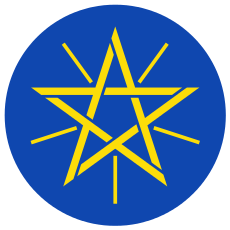Oromo Peoples' Democratic Organization
Oromo Peoples' Democratic Organization | |
|---|---|
|
| |
| Chairman | Lema Megersa |
| Deputy Chairman | Vacant |
| Founded | March 1982[1] |
| Headquarters | Addis Ababa, Ethiopia |
| Youth wing | OPDO Youth League |
| Ideology |
Marxism, Socialism, Oromo self-determination |
| National affiliation | Ethiopian People's Revolutionary Democratic Front |
| Party flag | |
 | |
| Website | |
| http://www.opdo.org.et/ | |
 |
| This article is part of a series on the politics and government of Ethiopia |
|
|
Judiciary
|
The Oromo Peoples' Democratic Organization (OPDO) is a political party in Ethiopia, and part of the alliance with the Amhara National Democratic Movement, the South Ethiopian Peoples' Democratic Front and the Tigrayan Peoples' Liberation Front that forms the Ethiopian People's Revolutionary Democratic Front (EPRDF). At the last legislative elections, 15 May 2005, the party was part of the Ethiopian People's Revolutionary Democratic Front, that won 327 out of 527 seats.[2]
In the August 2005 Regional assembly elections, the party won 387 out of 537 seats in the Oromia Region, and 14 out of 36 seats in the Harari Region.[3]
History
The OPDO was created in 1990 after the relations of the existing Oromo Liberation Front with TPLF soured while they were fighting against the Derg regime. In a recent book authored by Gebru Asrat (ሉዓላዊነትና ዴሞክራሲ በኢትዮጵያ ገብሩ አስራት 2006 ዓ.ም), a veteran TPLF leader who was one of those that masterminded the creation of OPDO, the author said that TPLF had to resort to its Oromo speaking war captives to recruit members for the organization once Oromos living abroad including those refugees in the Sudan and the wider Oromo diaspora in North America & Europe rejected TPLF's call to join the organization to be formed anew. Citing the role of elites in articulating political, economic & cultural problems in any society, Mr. Gebru argued, in his book, that since these members of the Oromo speaking war captives who formed OPDO had neither that capability nor sociopolitical know-how to understand & articulate Oromo problems at the time, it was clear from the very outset that the OPDO will live with deficiency of legitimacy among the Oromo society. At first a weak organization, according to Paul B. Henze, the OPDO attracted defectors from Derg military units and gained supporters when in 1991 the EPRDF occupied parts of the provinces of Wollo and Shewa which had significant Oromo majorities.[4] Yet generally, it is now a well established understanding among all Ethiopians that OPDO was created to serve as the instrument for limiting Oromo role in Ethiopia’s political and economic life while claiming to represent Oromo interest in the EPRDF coalision. It is this contradictory mission of the OPDO that has been the cause of wreaking havoc in Oromia region over the last quarter a century.
In 2001, the OPDO was rocked by a series of corruption scandals, which led to the ouster of then secretary general Kuma Demeksa on charges of corruption, "anti-democratic practices", abuse of power and nepotism. Major-General Abadula Gemeda at the time resigned his commission in the Ethiopian National Defense Force and took control of the entroubled OPDO.[5]
The OPDO held their fourth congress on 23 February 2006 in Adama.[6]
In the 2008 by-elections, the OPDO won 23 seats in the Oromia Regional legislature, and 613 seats from 108 kebeles for elections to the Kebeles Peoples' Representatives Council.[7]
Notes
- ↑ About us OPDO
- ↑ Ethiopian House of Peoples' Representatives Website
- ↑ African Elections Database
- ↑ Paul B. Henze, Layers of Time: A History of Ethiopia (New York: Palgrave, 2000), p. 322.
- ↑ "Ethiopian general opts for politics", BBC-Africa, 30 July 2001 (accessed 13 March 2009)
- ↑ "The Fourth Conference of O.P.D.O. Kicks off at Adama" (Oromia State Government website, accessed 6 October 2006)
- ↑ "The National Electoral Board of Ethiopia Official Result of the Local and By-Elections Held on April 13 and April 20, 2008", Walta Information Center, May 2008 (accessed 17 March 2009)